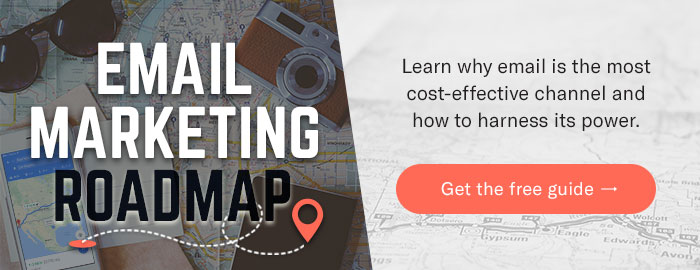Email marketing is by no means in its infancy. Email is over 40 years old, so by now there shouldn’t be too many surprises. However, while the platform itself has remained relatively unchanged over time, there are always new features and trends that have the potential to shake things up for recipients and senders alike.
Also, no matter what stage of email marketing your business might be in, it’s always helpful to have a roadmap to follow. Download our 2015 Roadmap to Email Marketing for Business Owners.
Drumroll, please… here are my 5 email marketing predictions for 2015:
1) Inbox Design Changes Will Push Marketers to Make Better Content
Sending and receiving email has been relatively unchanged from the perspective of the inbox. Sure, we can mark different priorities, create automation filters to folders, rely on SPAM filters to weed out the garbage and more. However, no matter how organized we can get our inboxes on our own, Google is determined to help us all make them even better.
Just like Google did in 2010 with Priority Inbox and again in 2013 with Tabbed Inbox, this year, the Gmail team released another tool to help people keep their inboxes tidy. While not available for everyone (yet), Inbox by Gmail is an entirely new email experience for your phone (and desktop) designed to cluster related emails.
The biggest feature that marketers should take note of is the “low priority” grouping. I’ve been using Inbox for a few months and I have to say, having all of my email newsletters clustered in one place is both convenient (delete all at once) and frightening for me (as a marketer). Here’s what my organized inbox look like:

On the personal side, it’s great to be able to bulk-delete the lower quality emails I don’t want to read. But like any tool that works to organize what’s important to you, there’s a lot of training that has to be done. What this means is that some of the newsletters I regularly read are incorrectly marked as low priority. It’s just an extra step to get it to show up in my regular inbox again, but a step nonetheless.

On the marketing side, this means that your emails have to shine. I mean, really knock it out of the park. The content you produce has to be focused on what your audience cares about and less about selling yourself or business. Good content marketing rewards you in the long run.
Without good content marketing, your email marketing won’t achieve its full potential. In 2015, we’ll see a lot more businesses writing custom content for their email marketing that seeks to entertain, inspire and engage their audiences.
2) Heavy Investment in Email Automation
78% of successful marketers say that marketing automation is most responsible for improving revenue contribution. You’re probably more familiar with marketing automation than you realize. Have you ever visited a page on Amazon and then a day later, see an ad for the product on your Facebook page? That’s a broad example of marketing automation.
In 2015, you’ll see more interest specifically in email marketing automation. While email automation has been around for a while, it’s becoming more accessible (and understood) by businesses large and small. Here are three of the different forms of email marketing automation you’ll see more of in 2015.
Automated email newsletters are a big selling point for a lot of companies. Having frequent touches to your past and present clients not only keeps you top of mind with them, but also increases your repeat and referral business. You just have to be sure that the content you’re automatically sending to your email lists is correctly targeting them and their interests. This is what OutboundEngine specializes in.
Another form of email marketing automation comes from different triggers. For example, if you scroll to the top of this page and sign up for the blog, you’ll get an automated email from me asking how I can help you become a better marketer. Similar triggers can be set up to automate other things too. Request a demo on our site and an email will be sent to your inbox until we can get in touch with you. Download a how-to guide from us and it’ll be sent to your inbox too. These triggers help marketers save time and increase audience engagement.
The other type of email automation that experienced marketers have used for years now is email nurturing. The idea here is to get your prospects through the sales funnel. So your first emails to a new prospect might be lower hanging commitments like links to your latest blog posts. If they click on those enough, the next emails they would get would promote a how-to guide. After downloading that, the final email would lead them to see a sales demo. While this is an abridged example, this illustration shows you how much time can be saved on the back end.
With the benefits of automated email marketing becoming more and more evident, I see more large and small businesses investing in automated solutions to make their lives easier and their marketing dollars more profitable.
3) Experimenting with Segmentation
Email list segmentation refers to the process of organizing your email contacts into different groups, allowing for more targeted and specific email communications to reach a pre-determined portion segment. Email list segmentation is a very smart approach to email marketing as it works to get the right messages to the right people at the right time.
Email list segmentation pairs quite well with the email marketing automation activities I mentioned earlier. As more people become familiar with marketing automation, they’ll also begin to see the benefits of segmenting their email lists too. Especially considering that companies using email list segmentation saw 39% higher open rates and 28% fewer unsubscribes with their email marketing.
For example, while you might have your entire contact database (customers and prospective customers) set to receive your automated email newsletters, you might want to send an offer to only your prospects. Since you wouldn’t want to send that sales email to your existing customers (as it wouldn’t be relevant to them), having your new prospects in a different email segment could help you more specifically target your message to a receptive audience.
Or if you’re in an industry (like OutboundEngine) that caters to a variety of industries, some of the more tailored content just wouldn’t make sense if sent to our entire email database. So when I sent out an email in December about marketing ideas for 2015, the real estate agents in our database received a link to the post 9 Pro Tips: Marketing Ideas for Real Estate Agents in 2015 and our insurance agent prospects were directed to the post 5 Referral-Driving Marketing Secrets for Insurance Agents in 2015.
As more businesses learn the importance of clean data and strong list segmentation in 2015, they’ll invest in ways to use that knowledge to their advantage.
4) The Rise of Incredible Subject Lines
Even with the best email automation and list segmentation in place, you still need your recipients to open their emails. As more and more businesses invest in email marketing and service providers (like Gmail) work to lessen the burden of a cluttered inbox, the competition you’ll have to get your emails seen and opened is rising sharply.
The numbers don’t lie on this one either. 64% of people say they’ll open an email because of the subject line alone, so you have to make every word enticing, targeted, exciting and informative to get them to respond. And not to add additional pressure, but you only have about three to four seconds to grab your readers’ attention and interest them enough to open and read your email.
I’ve written about subject lines before and how they can impact the deliverability of your emails. However, I recently came across a study of 260 million emails that yielded some interesting results about the number of words in subject lines compared to open rates:
- Subject lines with 6-10 words generated a 21% open rate.
- Subject lines with 5 or fewer words were opened approximately 16% of the time.
- Subject lines with 11-15 words have around 14% open rate, through 52% of the emails were in this range.
While this isn’t concrete evidence one way or the other, it does illustrate how the various ingredients of a subject line can have quantifiable implications. That’s why in 2015 you’ll see a lot of people spending an increased amount of time learning how to write good subject lines and testing to see what works and what doesn’t.
5) Increased Value Placed on Mobile Design
Did you know that four years ago, more than 90% of email was opened on desktop computers? Jump ahead to 2013 when we learned that mobile email opens surpassed the 50% mark. And even more impressive, 68% of Gmail and Yahoo users’ opens occurred on mobile devices.
Fast forward to 2014 and there has been a profound shift: 66% of brand marketing emails were opened on mobile devices. To put that into an even more perspective, in Q1 of 2014, more email was opened on iPhones (38%) alone than all desktops combined (34%).
Guess what? This means that mobile-ready emails are no longer a nice-to-have but an essential element of your marketing strategy. And you can believe that it’ll be a major focus of email marketing in 2015 too.
It’s important to highlight that there are three flavors of mobile email design that you can use: scalable, fluid and responsive design. While I won’t cover those here, you can read more about them in depth in our 2015 Roadmap to Email Marketing.
Wrap-up
To recap, here are my 5 email marketing predictions for 2015:
- Gmail apps like Inbox will push email marketers to become better content marketers
- Businesses of all sizes will invest heavily in email marketing automation
- Marketing automation will drive people to learn about and use email list segmentation
- Increased inbox competition will inspire a renewed interest in subject line creation
- Mobile usage stats will be unavoidable and cause businesses to adapt
And whether you’re just getting started or have been using email marketing for years, there’s something for everyone in our 2015 Roadmap to Email Marketing Guide.
While trends and best practices change from year to year, email still remains a central constant to any successful business. What email marketing predictions do you have for 2015? Let me know in the comments below!



![Better Email Etiquette Equals Better Marketing Results [16 Rules]](https://www.outboundengine.com/wp-content/uploads/shutterstock_411184843-1-400x250.jpg)

